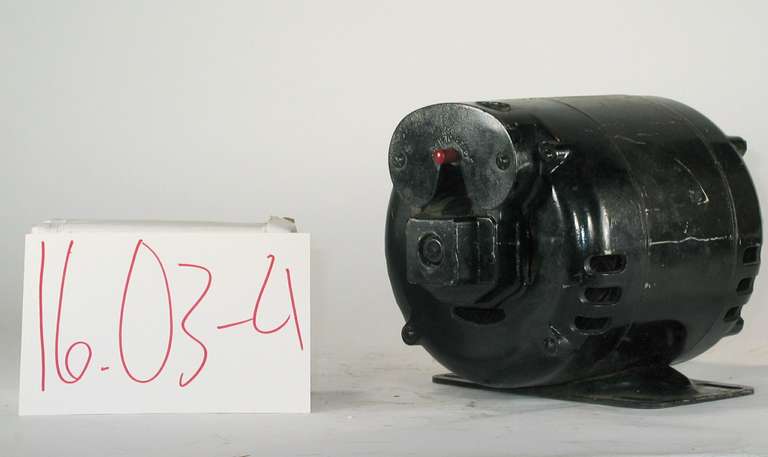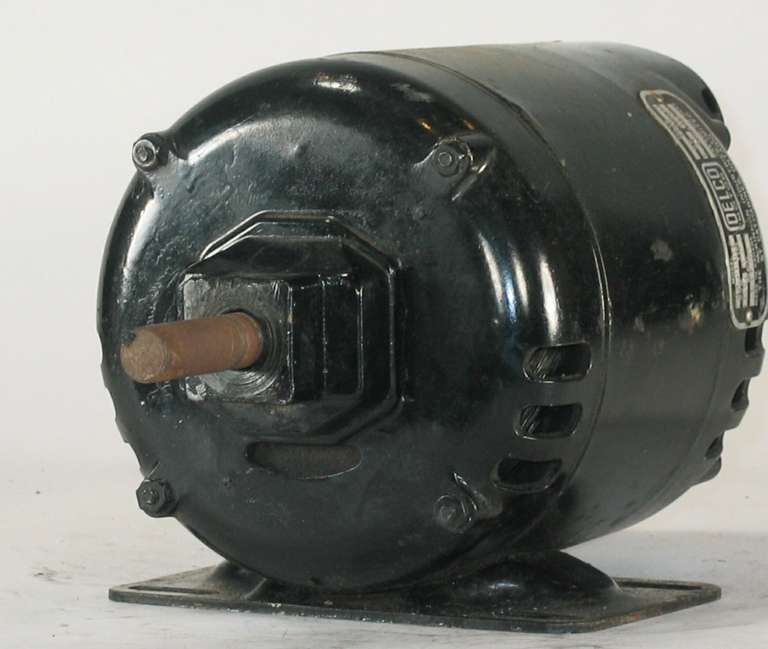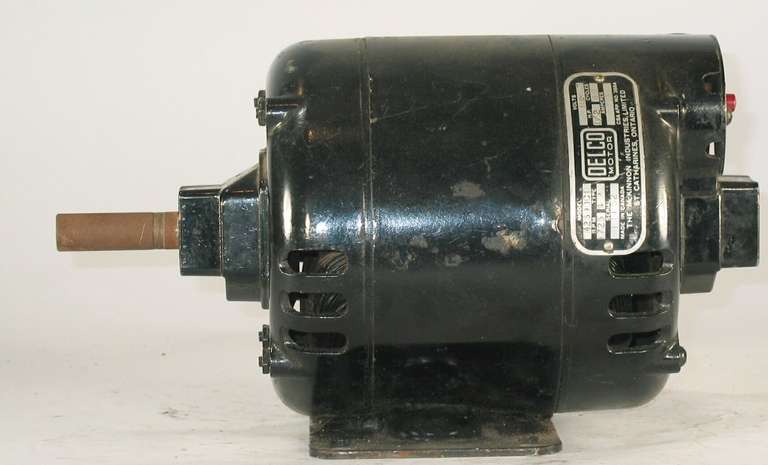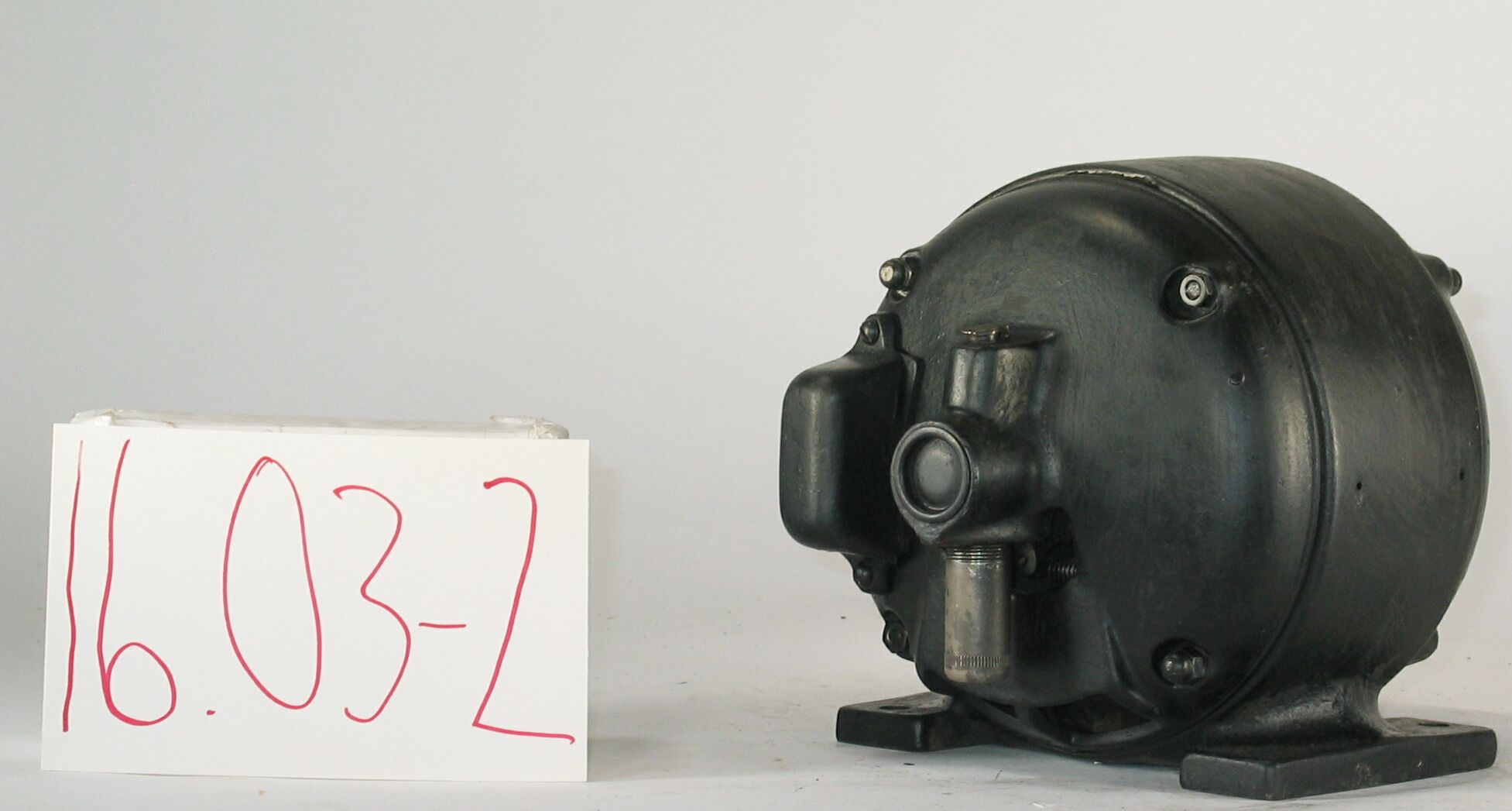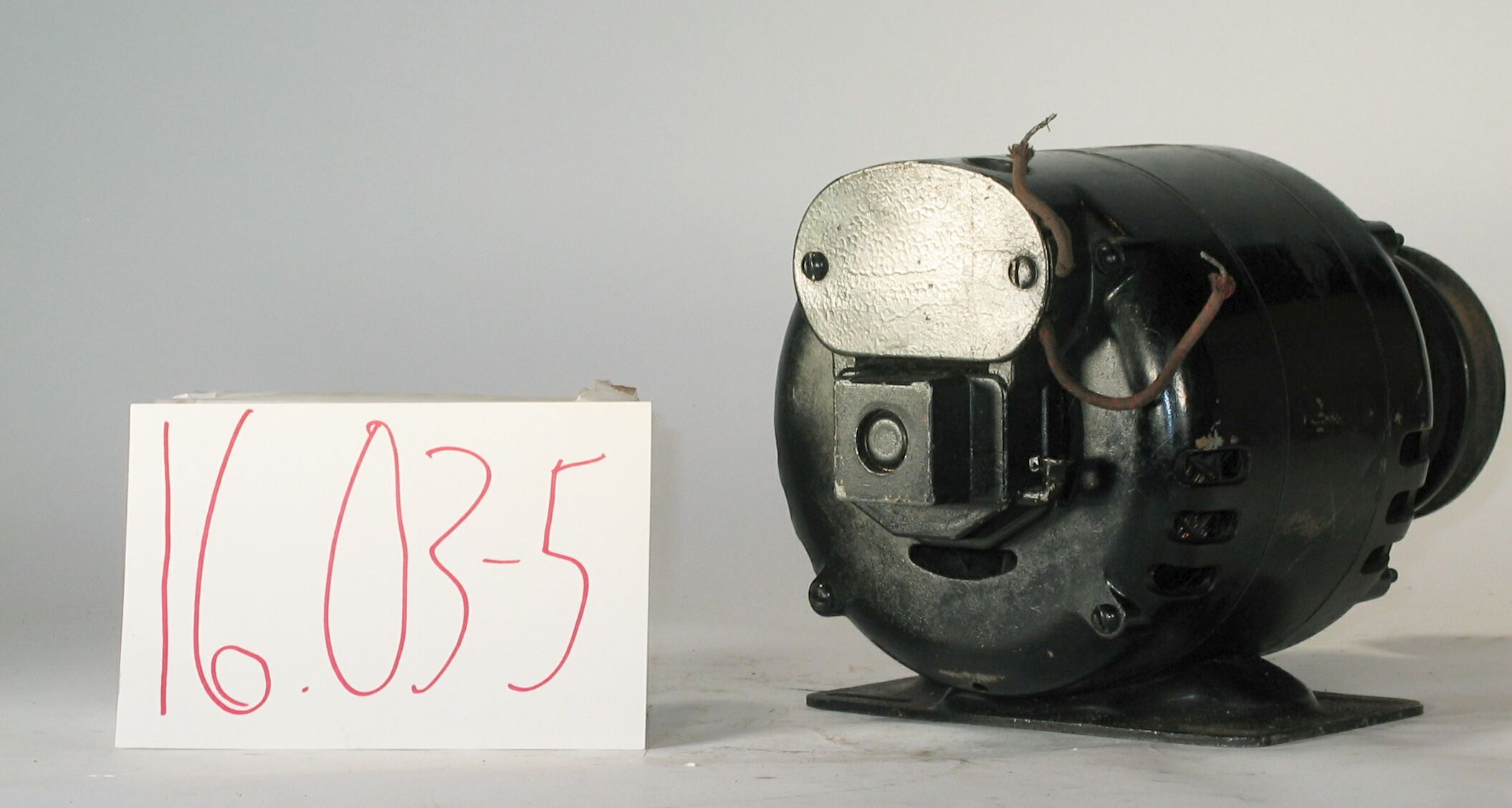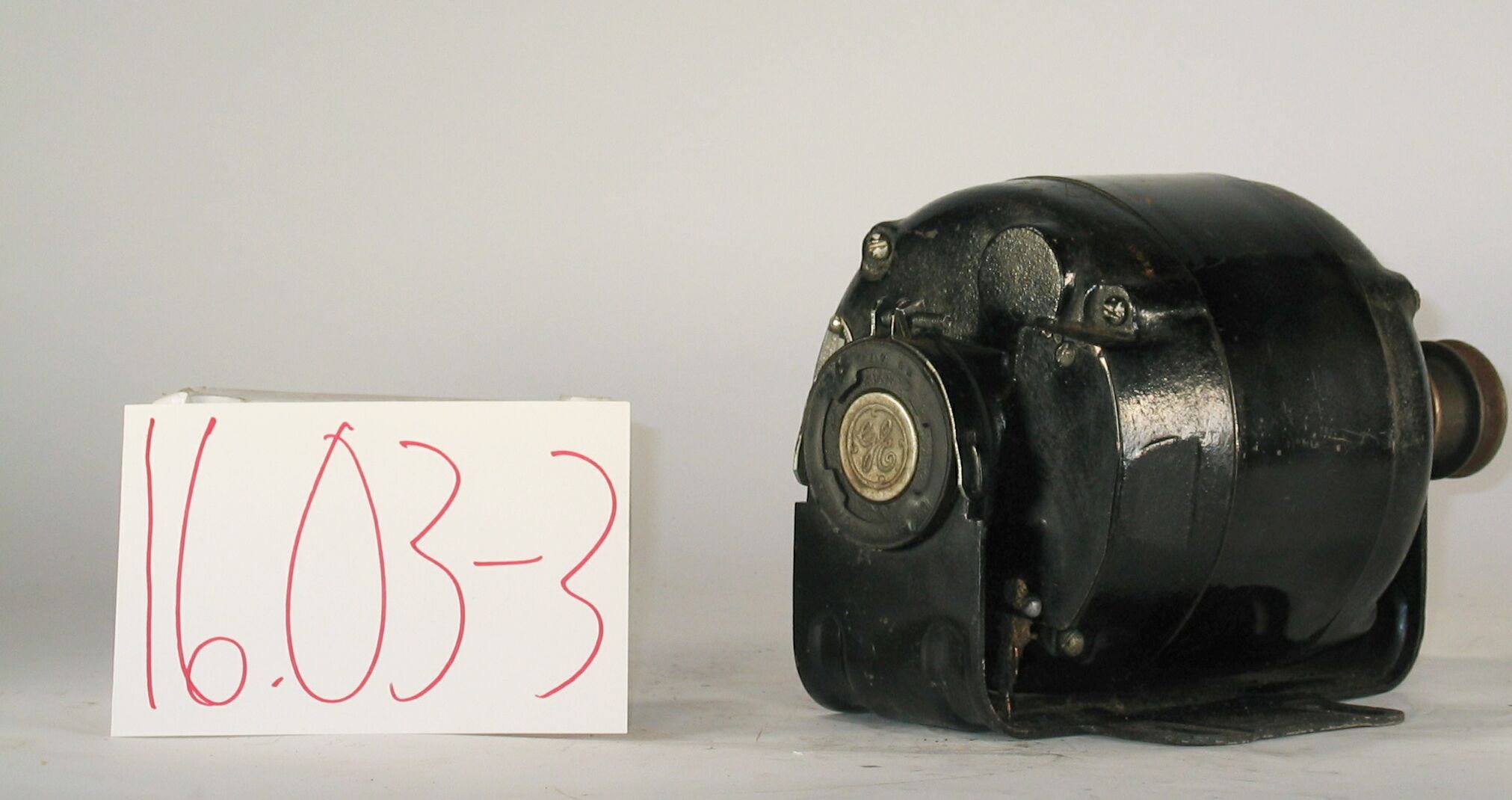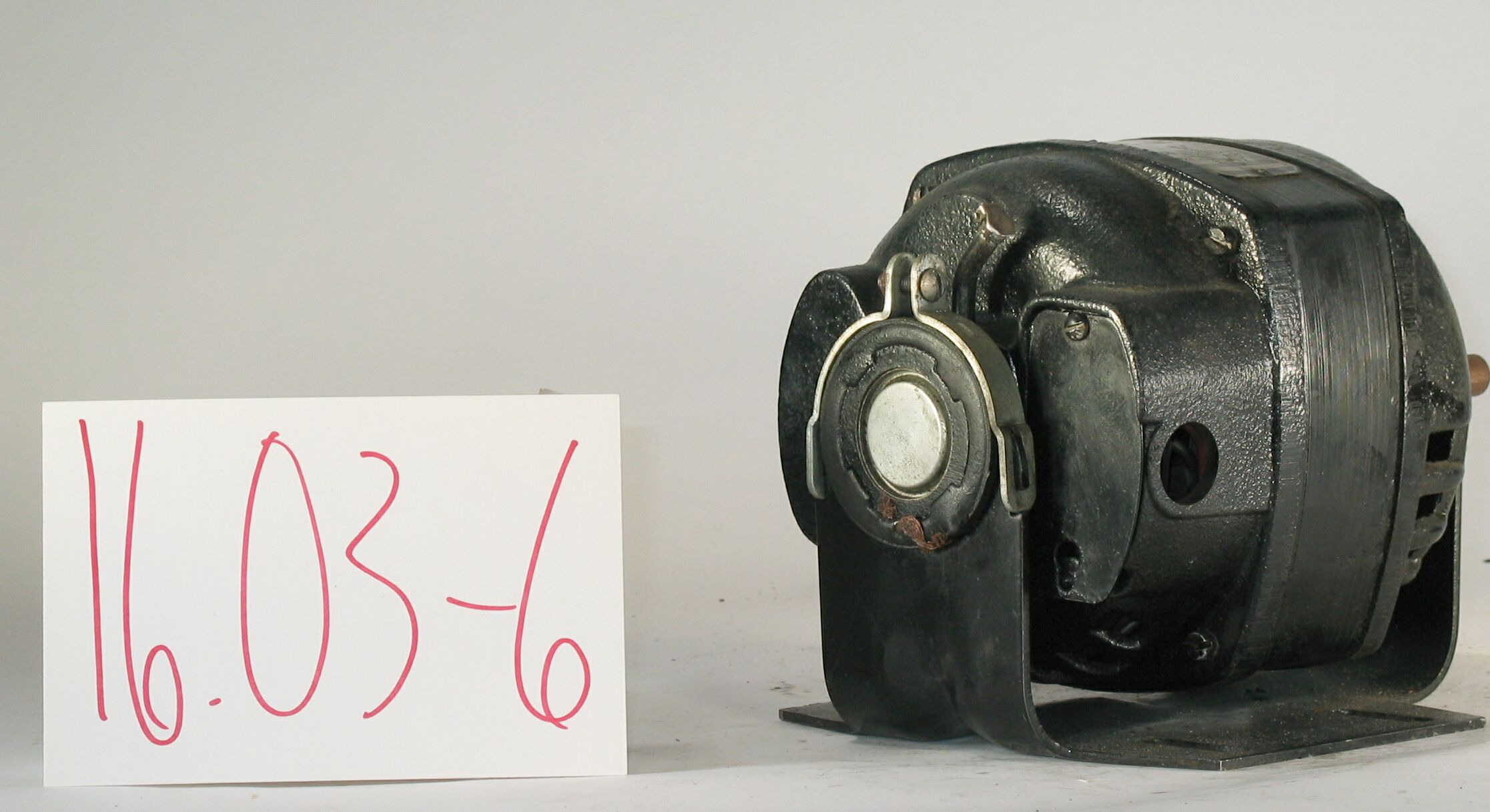16.03-4: Delco 1958 Split Phase, Induction Motor
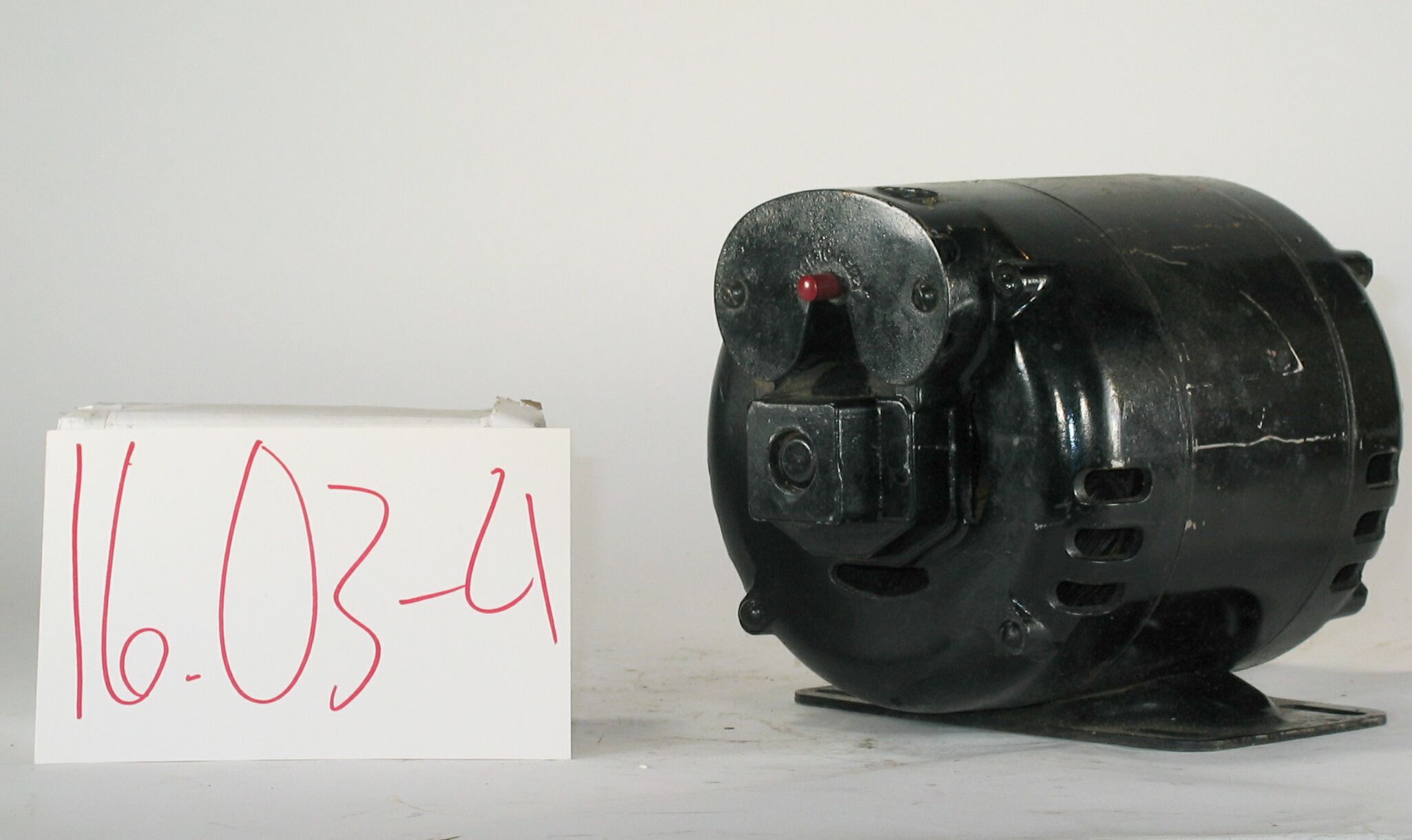
| HHCC Accession No. 2006.166 | HHCC Classification Code: 16.03-4 |
|---|
Description:
An early mid 20th century split phase, induction motor with ball bearings, built for the then rapidly expanding home workshop equipment industry in post W.W.II Canada, equipped with hefty ‘ horsepower rating and manual reset over load protection, it would be a marker of a significant cultural shift in male leisure time pursuits, Delco, Circa 1958.
Group:
16.03 Electric Motors - Single Phase, Split Phase
Make:
Delco
Manufacturer:
Mckinnon Industries St Catherines Ont.
Model:
M253901
Serial No.:
11152
Size:
12 x 7 x 6’h
Weight:
30 lbs.
Circa:
1958
Rating:
Exhibit, education, and research quality, illustrating the engineering and construction of a mid 20th century, 60 cycle, split phase, home appliance, and hobby shop motors
Patent Date/Number:
Provenance:
From York County (York Region) Ontario, once a rich agricultural hinterlands, attracting early settlement in the last years of the 18th century. Located on the north slopes of the Oak Ridges Moraine, within 20 miles of Toronto, the County would also attract early ex-urban development, to be come a wealthy market place for the emerging household and consumer technologies of the early and mid 20th century.
This artifact was discovered in the 1950’s in the used stock of T. H. Oliver, Refrigeration and Electric Sales and Service, Aurora, Ontario, an early worker in the field of agricultural, industrial and consumer technology.
With original shop repair service tag in Howard Olivers hand writing ‘Checks OK Jan, 75
Type and Design:
mid 20th century, resistance split phase induction motor, Engineered for the affordable, home workshop equipment market 1/4 horsepower, in drip proof, all steel body 60 cycle, 110 volt, alternating current, Internal, centrifugally operated switching for automatic control of starting winding Inherent over heat protection with manual reset Ball bearing
Construction:
Material:
Special Features:
Shop service tag in Howard Olivers hand writing ‘Checks OK Jan, 75
Accessories:
Capacities:
Performance Characteristics:
Operation:
Control and Regulation:
Targeted Market Segment:
Consumer Acceptance:
Merchandising:
Market Price:
Technological Significance:
Exemplifies the evolution of inherent, automatic overload protection devices with manual reset, a prerequisite requirement for home hobby shop equipment: Such applications typically rewired low starting torque [as on circular saws, but moderate horse power, current ratings, which could readily lead to burn out under high load conditions Motors were built for an affordable market and were built inexpensively, with little tolerance for prolonged loading [over loading], While automatic overload protection was considered an essential safety precaution, both for personal and property reasons, automatic reset would constitute a safety hazard, allowing the equipment to come back on out of control of operator,
Defines the engineering design idiom for split-phase, low starting torque, motor technology employed throughout the middle years of the 20th century in home appliances and hobby shop equipment, moving through the mature years of this genre towards the end of the century, when a new genre would progressively emerge, smaller, lighter and more energy efficient.
Industrial Significance:
The motor stands as a relatively rare marker of a breed of home hobby shop motor which would soon disappear. The stand alone, home hobby shop motor as a product of the post W.W.II market place, would be a relatively short lived phenomena. Early power tools of the period were, designed for the home work shop were of the conventional belt drive type, through the 1950’s to 80’s, but the trend was increasingly to much more integrated designs in which the motor was built into the equipment, itself, as an inherent design component.
A marker of split phase electric motor production in Canada and the US, in the latter years of the 20th century. Manufactured in the hundreds of thousands, by Delco, GE and other manufacturers, it stands as an icon of its times, marking the first great period mass production and marketing of electric, motorized household appliances and hobby shop equipment, now made possible by wide spread home electrification.
Socio-economic Significance:
A marker of the evolution and popularization of the home hobby shop in the post W.W.II years moving to the end of the 20th century, a period in which leisure time for males was increasingly possible, and the market place responded with a proliferation of power tools, taking advantage of the technology, and relative economic prosperity of the times.
Socio-cultural Significance:
Not-with-standing a major depression and two world wars the first half of the 20th century was a period of exceptional ferment in the development and popular dissemination of FHP electric motor technology. Associated with the development were a number of driving forces, mutually supporting and interacting: Scientifically, the theoretical ground work for development of an astonishing array of electrical and electro-magnet devices had been laid by the early years of the 20th century, through the efforts of Faraday and Steinnmetz, among many others, Technologically, the work of Thomas Edison, among others, laid the foundation stones on which urban and rural electrification would proceed, enabling an new era in human experience, favoured with consumer goods and services, previously unimagined,
Economically, a favourable climate for capital investment in manufacturing capacity, methods and materials emerged, part of North America’s second industrial revolution, Socially and culturally the consumer society was born, nurtured by a pent up demand for an easier, more comfortable, pleasurable lifestyle, and the sense that 20th century electrical and electro-motive technology might be able to help. The FHP electric motor, engineered for 110 volt, single-phase house current, revolutionized life in the Canadian home. It enabled an astonishing list of appliances and labour saving devices. The revolution would take place in an astonishingly short period of time - for much of urban Canada much less than a decade. The electro-mechanical mechanization of the Canadian home was accomplished for much of urban Canada by the late 1930’s. But the early 20th century wonders of household mechanization would be dependent , in turn, on household ‘electrification’ Between them electrification and electro-mechanical mechanization changed everything. Almost over night it altered what Canadians do in the course of their day, how they live and their expectations of what their world had in store for them - in labour saving devices, devices of convenience, health and safety. The fractional horsepower electric motor [FHP] became an ubiquitous part of the Canadian household by the mid 1930’s. Cyril Veinott reported, December 1938:
‘Practically every electrified home today makes use of one or more fractional horsepower motors. This kind of motor may be used in a washing machine, refrigerator, vacuum cleaner, clock, oil burner, hair drier, room heater, sewing machine, razor, health machine, fan, air conditioner, stoker, ironed, floor waxer, or food mixer. In industrial use, the number of useful tasks performed by fractional horsepower motors is legion. In the United States alone, the value of fractional horsepower motors sold amounts to approximately $50,000,000 annually.’ See reference #1
Similarly, more than half a decade earlier Daniel Braymer had commented on the proliferation of this mind and life changing technology for home electro-mechanization. He observed that what had made it all possible was the invention of single phase alternating current motor, in a number of subtypes, small quiet, self starting, reliable and affordable motors for the home, motors which were compatible with the rapid standardization of single phase, alternating current, electrical distribution systems then spreading across north America. See reference #2 Among the types of single phase alternating current motors which quickly populated the Canadian home were: repulsion induction [see Group 16.01] for heavy duty, high starting torque applications such as refrigeration appliances; capacitor start [see Group 16.02] for advanced high torque applications, requiring quiet operation; split Phase [see Group 16.04] for light duty low starting torque applications; and shaded pole [see Group 16.04] designs for small devices such electric fans. The FHP single phase induction motor, often unobtrusive, out of sight in a dark corner, has, none-the-less, been a principle foundation stone on which Canadian, popular consumer and household technology has evolved, throughout the 20th century and into the 21st - a driving force of profound, typically un-recognized, social, cultural and economic change [See reference 6]. Electro-motive technology [the FHP motor], along with electric and electronic communications technology [the telephone and broadcast radio] would invade the Canadian home starting in the 1920’s. Throughout the balance of the 20th century these technologies would trigger a vast, new, popular consumer culture, a ‘popular technological revolution’. Yet, simply because technology has so shaped the Canadian reality, it has also shaped much profound Canadian though about the technological experience, its meaning and significance for humanity. Included among the works of Canadian writers with an international reputation are: Arthur Kroker, George Grant, Ursala Franklin, Heather Menzies, among many others [See references 7, 8, 9, and 10]. From the vantagepoint of the 21st century noted Canadian writer Jane Jacobs asks, ‘Now we stand at another monumental crossroad, as agrarianism gives way to a technology-based future. How do we make this shift without losing the culture we hold dear’ [See reference 11]
Donor:
G. Leslie Oliver, The T. H. Oliver HVACR Collection
HHCC Storage Location:
Tracking:
Bibliographic References:
‘Fractional Horsepower Electric Motors’, Cyril Veinott, McGraw Hill New York, 1948 ‘Rewinding Small Motors’, Daniel Braymer and C.C. Roe, McGraw Hill, 1932 ‘Theory and Application of Capacitor-Start Induction Motors’, G. L. Oliver, Bachelor Thesis ,University of Toronto, Session 1951-52 ‘Modern Refrigeration and Air Conditioning’, Electric Motors, Chapter 7, Andrew Althouse and Carl Turnquist, Goodheart-Wilcox, 1960 ‘A course in Electrical Engineering, Volume II, Alternating Current’, Chester Dawes, McGraw Hill, 1934, Starting single Phase Induction Motors, P. 362. ‘The Fractional Horsepower Motor and its Impact on Canadian Society and Culture’, G. Leslie Oliver, Material History Review, Vol. 43, Journal National Museum of Science and Technology, 1996. ‘Technology and the Canadian Mind, Innis/ McLuhan/Grant’, Arthur Kroker, New World Perspectives, 1984. ‘Technology and Empire’, George Grant, Anansi, 1969, ‘The Real World of Technology’, Ursula Franklin, Anansi, 1993. ‘Fast Forward and Out of Control’, Heather Menzies, Macmillan, 1989 ‘Dark Ages Ahead’, Jane Jacobs, Random House, 2004
